Novartis Bundle
Who Really Owns Novartis?
Unraveling the ownership structure of a pharmaceutical behemoth like Novartis is crucial for understanding its strategic direction and future prospects. Formed from a landmark merger, Novartis has evolved significantly since its inception, impacting its stakeholders and the broader healthcare landscape. Understanding Novartis SWOT Analysis is essential to gain insights into its competitive positioning.
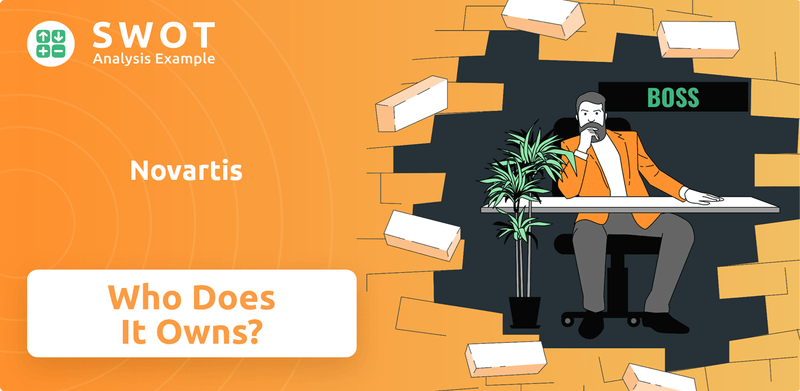
From its roots in a historic merger, Novartis has become a global leader, and understanding its ownership is key to grasping its operational dynamics. Examining the Novartis ownership structure, including its major shareholders and the influence of Novartis executives, offers valuable insights. This exploration will delve into the core of who controls Novartis, providing a comprehensive overview of the Novartis parent company and its impact on the company's trajectory, including its subsidiaries.
Who Founded Novartis?
The story of the Novartis company begins with the 1996 merger of Ciba-Geigy and Sandoz, two Swiss companies with deep roots in the chemical and pharmaceutical industries. This merger created what we know today as Novartis, a global healthcare leader. Understanding the founders and early ownership helps to trace the company's evolution from its origins to its current structure.
The foundational entities of Novartis, Ciba-Geigy, and Sandoz, each had their own distinct beginnings. J. R. Geigy, established in 1758, was one of the earliest predecessors. Ciba's roots trace back to 1859, and Sandoz was founded in 1886. These companies initially focused on chemicals and dyes before expanding into pharmaceuticals.
The merger that formed Novartis involved the pharmaceutical and agrochemical divisions of Ciba-Geigy and Sandoz. After the merger, Novartis became an independent entity, publicly traded. Other parts of Ciba-Geigy and Sandoz were either sold or spun off as separate companies.
J. R. Geigy (1758), Ciba (1859), and Sandoz (1886) were the primary companies that led to the formation of Novartis.
Initially, the companies were involved in chemicals, dyes, and materials. They later diversified into pharmaceuticals.
Ciba and Geigy merged in 1970 to form Ciba-Geigy Ltd., which later became part of the Novartis merger.
Ciba produced its first pharmaceutical substances in 1900, and Sandoz in 1895, marking their entry into the pharmaceutical sector.
The merger of Ciba-Geigy and Sandoz in 1996 resulted in the creation of Novartis, focusing on pharmaceuticals and agrochemicals.
Following the merger, Novartis became a publicly traded company, with ownership distributed among shareholders.
The ownership of Novartis, as a publicly traded company, is now dispersed among various shareholders. To learn more about the company's journey, you can read a Brief History of Novartis. The current ownership structure reflects this public nature, with no single entity holding a controlling stake. The company's shares are traded on major stock exchanges, allowing a wide range of investors to participate in its ownership. Key aspects to consider include the composition of the board of directors, the influence of major institutional investors, and the overall market capitalization, which fluctuates daily based on stock performance and market conditions. As of early 2024, Novartis continues to be a significant player in the pharmaceutical industry, with its ownership structure reflecting its status as a global, publicly-held corporation.
Understanding the historical context of Novartis helps to clarify its current ownership structure and its place in the pharmaceutical industry.
- Novartis was formed through the merger of Ciba-Geigy and Sandoz.
- The company is publicly traded, with ownership distributed among shareholders.
- The initial companies were involved in chemicals and dyes before expanding into pharmaceuticals.
- The current ownership structure reflects its global, publicly-held corporation status.
Novartis SWOT Analysis
- Complete SWOT Breakdown
- Fully Customizable
- Editable in Excel & Word
- Professional Formatting
- Investor-Ready Format
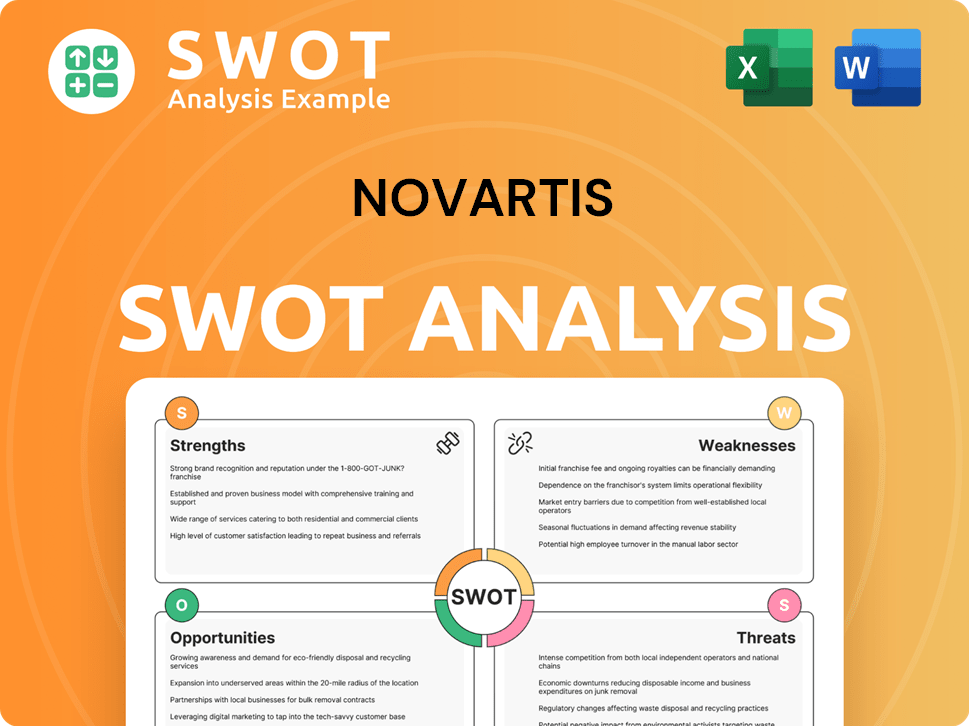
How Has Novartis’s Ownership Changed Over Time?
The ownership of the Novartis company is multifaceted, primarily due to its status as a publicly traded entity. Novartis's growth strategy has been significantly influenced by its ownership structure. The company's shares are widely held by various investors, including institutional investors, mutual funds, and individual shareholders. Novartis was officially founded in March 1996, and its IPO date for its ADRs on the NYSE is November 18, 1991, reflecting the listing of its predecessor companies. This broad ownership base means that no single entity or family controls the company.
Key events have shaped the Novartis ownership structure. The spin-off of the eye-care division Alcon in April 2019 and the spin-off of Sandoz in October 2023 significantly altered the company's structure. These strategic moves allowed Novartis to concentrate on innovative medicines. As of June 13, 2025, Novartis AG had a market capitalization of $234.52 billion, increasing by 15.31% in one year. Its market capitalization was CHF 198.58 billion in June 2025. These changes reflect the company's adaptation to market dynamics and investor expectations.
| Metric | Value | Date |
|---|---|---|
| Market Capitalization | CHF 198.58 billion | June 2025 |
| Market Capitalization Increase (Year-over-Year) | 15.31% | June 2025 |
| Institutional Holdings Increase | 0.4041% | May 2025 |
The major stakeholders of Novartis include a diverse group of institutional investors and individual shareholders. While specific percentages fluctuate, institutional ownership trends are tracked through filings. In May 2025, institutional holdings increased by 0.4041%. These shareholders collectively influence the company's strategic decisions and governance. The company's leadership and board of directors are responsible for managing the company and responding to the expectations of its shareholders.
Novartis is a publicly traded company with a broad ownership base, primarily held by institutional investors and individual shareholders.
- The company's market capitalization was $234.52 billion as of June 13, 2025.
- Institutional holdings saw an increase of 0.4041% in May 2025.
- Strategic spin-offs, like Alcon and Sandoz, have reshaped the company's focus.
- The company's governance is influenced by diverse shareholders.
Novartis PESTLE Analysis
- Covers All 6 PESTLE Categories
- No Research Needed – Save Hours of Work
- Built by Experts, Trusted by Consultants
- Instant Download, Ready to Use
- 100% Editable, Fully Customizable
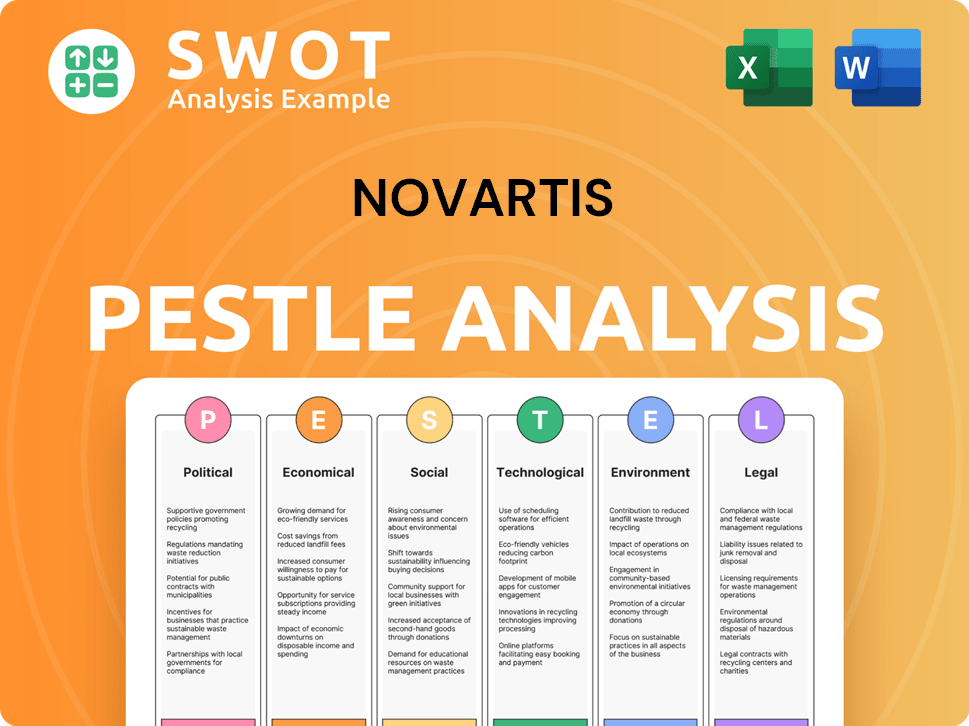
Who Sits on Novartis’s Board?
The Board of Directors of the Novartis company plays a crucial role in its governance. At the 2025 Annual General Meeting (AGM) held in March 2025, shareholders elected Dr. Giovanni Caforio as a new member of the Board of Directors and the new Board Chair, with over 98% support. He will replace Jörg Reinhardt, who is retiring in 2025 after a 12-year term. Dr. Elizabeth (Beth) McNally was also elected as a new member with over 99% support. Existing board members who stood for re-election were also re-elected.
The composition of the board reflects a mix of members with diverse backgrounds, including those with extensive industry experience. The board's decisions are crucial in shaping the company's strategic direction and ensuring effective oversight. The board's structure and the election results from the 2025 AGM highlight the importance of shareholder engagement and the company's commitment to strong corporate governance. Understanding the Novartis ownership structure and the roles of its executives is vital for investors and stakeholders alike. For more insights into the company's approach, consider exploring the Marketing Strategy of Novartis.
| Board Member | Role | Election Support (2025 AGM) |
|---|---|---|
| Dr. Giovanni Caforio | Board Chair | Over 98% |
| Dr. Elizabeth (Beth) McNally | Board Member | Over 99% |
| Jörg Reinhardt | Outgoing Board Chair | N/A (Retiring) |
Novartis operates under a one-share-one-vote structure. This means each share generally carries equal voting rights. The company's Articles of Association and SEC filings, such as Form 20-F, outline the voting structure and governance principles. Decisions at the Annual General Meeting, such as the approval of the dividend increase to CHF 3.50 per share for 2024 (a 6.1% increase), are made by shareholder vote, with resolutions typically requiring significant support. For example, the proposal to cancel shares repurchased during 2024 and to authorize further share repurchases up to CHF 10 billion from the 2025 AGM to the 2028 AGM received 99.5% support from shareholders.
The Board of Directors is pivotal in Novartis's governance, with recent elections reflecting strong shareholder support and commitment to experienced leadership.
- Dr. Giovanni Caforio elected as Board Chair with over 98% support.
- Dr. Elizabeth (Beth) McNally joined the board with over 99% support.
- Shareholders approved a dividend increase and share repurchase program with overwhelming support.
- The company maintains a one-share-one-vote structure, ensuring equitable voting rights.
Novartis Business Model Canvas
- Complete 9-Block Business Model Canvas
- Effortlessly Communicate Your Business Strategy
- Investor-Ready BMC Format
- 100% Editable and Customizable
- Clear and Structured Layout
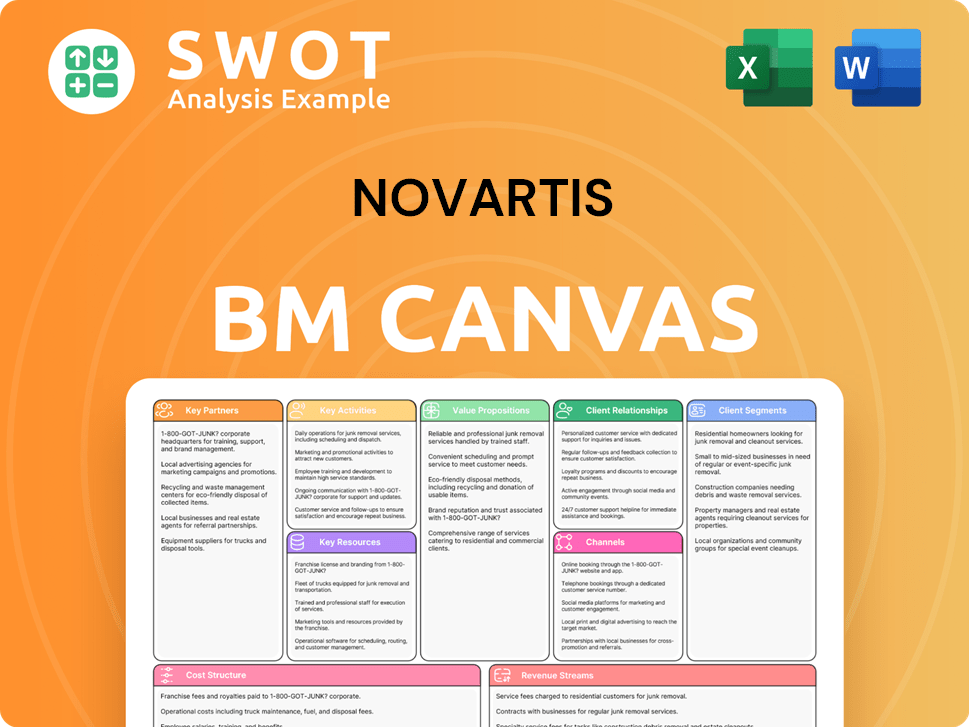
What Recent Changes Have Shaped Novartis’s Ownership Landscape?
In the last few years, the Novartis company has seen significant shifts in its ownership and strategic direction. A major move was the spin-off of its generics division, Sandoz, completed in October 2023. This strategic decision aimed to sharpen focus and drive returns by concentrating on its innovative medicines pipeline. These changes are key aspects of understanding Novartis ownership and its future trajectory.
Novartis shareholders have also been impacted by the company's capital allocation strategies. The company has been actively involved in share buyback programs. In July 2023, a plan to repurchase up to $15 billion of shares by the end of 2025 was announced. As of January 2025, approximately $5.4 billion of this program was still to be executed. In 2024, the company repurchased 77.5 million shares for $8.3 billion. Shareholders further approved the authorization for the Board of Directors to repurchase shares up to CHF 10 billion from the 2025 AGM to the 2028 AGM, in addition to a remaining authorization of CHF 3.5 billion from prior AGMs.
| Metric | Details | Year |
|---|---|---|
| Share Repurchases | $8.3 billion | 2024 |
| Remaining Share Buyback Program (as of Jan 2025) | $5.4 billion | 2025 |
| Authorized Share Repurchase (2025-2028) | CHF 10 billion | 2025-2028 |
Novartis executives have also been involved in significant M&A activity. Over 30 bolt-on deals were completed in 2023-2024 to enhance its pipeline. Recent acquisitions include Anthos Therapeutics for $925 million in February 2025, Dren Bio for up to $3 billion in July 2024, and Ratio Therapeutics for $745 million in November 2024. These moves highlight a focus on early-stage opportunities to fuel growth into the 2030s. To better understand the pharmaceutical industry, and how Novartis fits in, you can explore the Competitors Landscape of Novartis.
Novartis acquired Anthos Therapeutics in February 2025 for $925 million. Dren Bio was acquired for up to $3 billion in July 2024, and Ratio Therapeutics for $745 million in November 2024.
The company announced plans to repurchase up to $15 billion of its shares through the end of 2025. In 2024, Novartis repurchased 77.5 million shares for $8.3 billion.
Novartis is now a pure-play innovative medicines company after the spin-off of Sandoz in October 2023. This allows for a sharper focus on its core therapeutic areas.
Novartis aims to continue its strong sales growth with margin expansion in 2025, forecasting net sales growth in the mid- to high-single digits and core operating income growth in the high single- to low double-digit range at constant currency.
Novartis Porter's Five Forces Analysis
- Covers All 5 Competitive Forces in Detail
- Structured for Consultants, Students, and Founders
- 100% Editable in Microsoft Word & Excel
- Instant Digital Download – Use Immediately
- Compatible with Mac & PC – Fully Unlocked
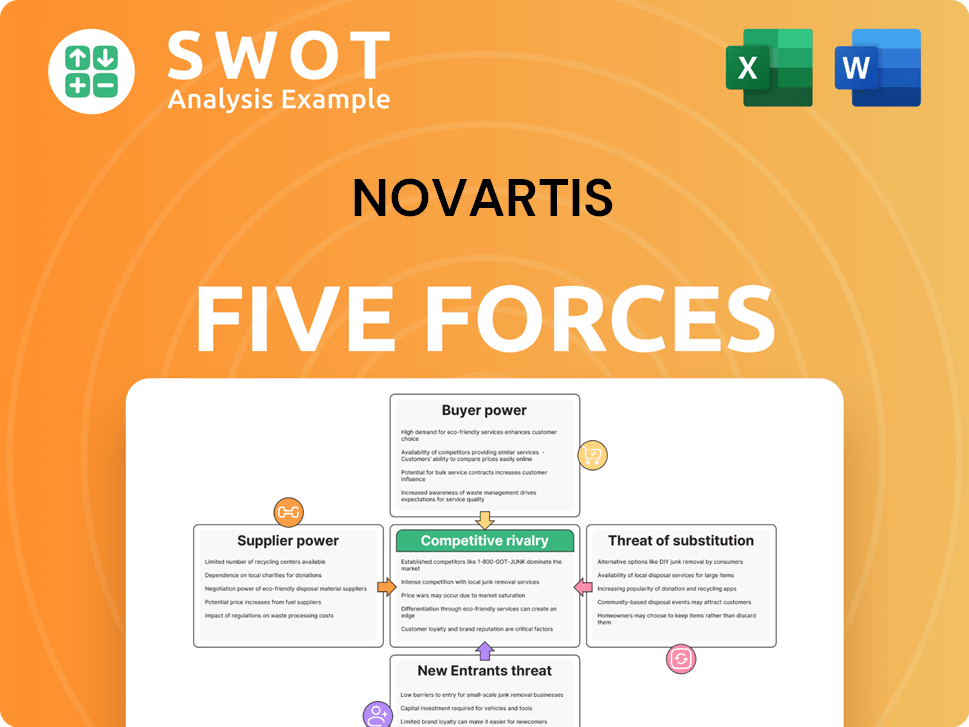
Related Blogs
- What are Mission Vision & Core Values of Novartis Company?
- What is Competitive Landscape of Novartis Company?
- What is Growth Strategy and Future Prospects of Novartis Company?
- How Does Novartis Company Work?
- What is Sales and Marketing Strategy of Novartis Company?
- What is Brief History of Novartis Company?
- What is Customer Demographics and Target Market of Novartis Company?
Disclaimer
All information, articles, and product details provided on this website are for general informational and educational purposes only. We do not claim any ownership over, nor do we intend to infringe upon, any trademarks, copyrights, logos, brand names, or other intellectual property mentioned or depicted on this site. Such intellectual property remains the property of its respective owners, and any references here are made solely for identification or informational purposes, without implying any affiliation, endorsement, or partnership.
We make no representations or warranties, express or implied, regarding the accuracy, completeness, or suitability of any content or products presented. Nothing on this website should be construed as legal, tax, investment, financial, medical, or other professional advice. In addition, no part of this site—including articles or product references—constitutes a solicitation, recommendation, endorsement, advertisement, or offer to buy or sell any securities, franchises, or other financial instruments, particularly in jurisdictions where such activity would be unlawful.
All content is of a general nature and may not address the specific circumstances of any individual or entity. It is not a substitute for professional advice or services. Any actions you take based on the information provided here are strictly at your own risk. You accept full responsibility for any decisions or outcomes arising from your use of this website and agree to release us from any liability in connection with your use of, or reliance upon, the content or products found herein.